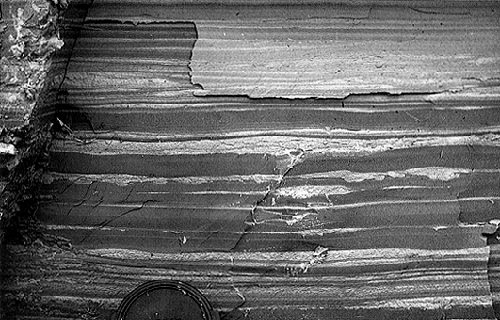
Parallel bedding: close-up view
Plate 3

Parallel bedding: close-up view
Plate 3
Skipping several orders of magnitude in scale, we approach here bedding from a distance of a few decimeters (notice lens cap at the bottom of the picture). Fine geometrical details are thus observable, along with the lithology and texture of sediments. It can be seen that darker beds are more finely textured: they represent compacted mud (mudstone) alternating rather regularly with beds of fine sand and silt. Such an alternation of two kinds of sediments, or lithotypes, is called by some a rhythmite. The term alludes to the fact that there is a repetitive superposition of the same basic motif of deposition, a sort of rhythm. Each unit of this rhythm is a couple of beds (sand/mud), i.e., a layer. The thickness is in the order of centimeters (thin to medium bedding).
Two possible explanations come to mind for these couplets: 1) the mud settled, slowly and continuously, from a suspension when the water near the bottom was calm (if it is agitated, the particles are kept suspended). From time to time, a stronger current arrived, laid down its load of sand and silt, and decayed; 2) not each bed but each layer (couple) represents a waning current. Deposition started in every event with the heavier and coarser material, followed by the lighter and finer one. Nothing was deposited before the arrival of the next flow.
Under the first hypothesis, two distinct sedimentary events (a background of fine sediment rain punctuated by sporadic inputs of sand-carrying flows of higher energy) alternate in time and make the couplet; under the second assumption, only one event, or sediment inflow, makes a couplet, with a change in sediment texture occurring during the event.
Some sand beds have a wavy top, which reflects the profile of ripples. The implication is that, when a current capable of rippling the sand slows down and stops, the ripples are not canceled. The capping mud drape allows them to be preserved and to fossilize. Also, some deformational structures (see further on, plates 104 to 139) are visible at the base of a sand bed near the picture center: they consist of small lobes of sand sinking amid pointed crests of mud, and are classified as load structures.
Pleistocene lacustrine deposits near Todi, Umbria Region, Italy.
The basin where these sediments accumulated was a deep, subsiding lake formed by tectonic stretching (extension) of a newly uplifted chain (the Apennines). This kind of basin is generally called intra- or intermontane and characterizes late evolutionary stages of orogenic belts. This one was active in early Quaternary times (Pleistocene), and rapidly filled by sediments. The sediments were supplied by short-headed streams that drained nearby highlands; the influx was probably seasonal. No room was available to accommodate sedimentation along the lake border; therefore, the load of stream floods was emptied into a subaqueous slope where it formed density (turbidity) currents. Density flows could carry the sediment as far as the flat basin center. Seasonal rhythms of sedimentation, particularly in lakes, are also called varves after the Swedish term coined for glaciolacustrine deposits left by retreating glaciers after the last Ice Age in northern Europe.
Assuming that the Quaternary hydrological regime was similar to the Modern one in central Italy (two rainy seasons alternating with two drier seasons), every second couple would record a year. The two flood peaks might be, however, unequal, with one of them leaving no record. A single couplet should represent a year in this case. The conclusion is that one must be very cautious in defining (or, better, interpreting) varves and using sediments as geological clocks. It is safer to use the term varvelike for well and thinly bedded, rhythmic alternations deposited in calm water. Examples can be seen in plates 59 and 147.
| Photo: G. Basilici 1992. |